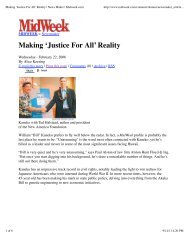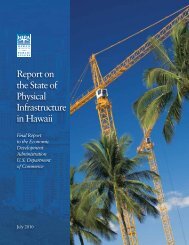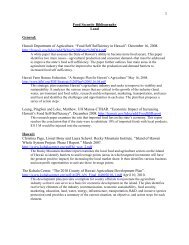Hawai'i Fisheries Initiative - The Hawaii Institute for Public Affairs
Hawai'i Fisheries Initiative - The Hawaii Institute for Public Affairs
Hawai'i Fisheries Initiative - The Hawaii Institute for Public Affairs
Create successful ePaper yourself
Turn your PDF publications into a flip-book with our unique Google optimized e-Paper software.
also refers to the incidental take<br />
of protected marine mammals and<br />
endangered species such as sea turtles and<br />
seabirds). Participating agencies include:<br />
Wespac, U.S. Fish and Wildlife Service,<br />
U.S. Coast Guard, and the NMFS Office of<br />
En<strong>for</strong>cement. 225<br />
Due to past issues with the incidental<br />
take of endangered species, 100 percent<br />
observer coverage is mandated in the<br />
shallow-set longline swordfish fishery.<br />
Approximately 30 vessels participated in<br />
the fishery in 2005, logging nearly 1,600<br />
fishing days a year (28 days on an average<br />
trip). <strong>The</strong> fishery closes once the annual<br />
bycatch cap of endangered loggerhead (17)<br />
and leatherback (16) turtles is reached. 226<br />
<strong>The</strong> longline tuna fishery has approximately<br />
25 percent observer coverage. In<br />
2005, 164 federal limited-entry longline<br />
permits were allowed in the fishery, and<br />
approximately 110 vessels actively fished.<br />
Bycatch includes several species of shark;<br />
incidental takes include loggerhead,<br />
leatherback, olive ridley, and green sea<br />
turtles; black-footed and Laysan albatross;<br />
dolphins; and pilot, humpback, false killer,<br />
and sperm whales. 227<br />
<strong>The</strong> observer program <strong>for</strong> the NWHI<br />
bottomfish fishery was initiated in 2003 to<br />
document protected species interactions<br />
(monk seals, seabirds). Data on catch<br />
and discards is also collected. <strong>The</strong> eight<br />
permitted vessels fished an average of<br />
1,200 days in 2005; observer coverage was<br />
20 percent. 228<br />
Monitoring and En<strong>for</strong>cement<br />
En<strong>for</strong>cement is labor and resource<br />
intensive. Effective en<strong>for</strong>cement depends<br />
on many factors: availability of personnel<br />
and equipment, cohesive management<br />
regimens in federal and state fisheries<br />
management plans, and the specific<br />
management plan being en<strong>for</strong>ced. State<br />
and federal en<strong>for</strong>cement agencies include:<br />
u U.S. Coast Guard – helicopters can spot<br />
vessels, NOAA/DLNR dockside agents<br />
board and inspect <strong>for</strong> violations 229<br />
u NOAA/NMFS Pacific Islands Division Office<br />
of Law En<strong>for</strong>cement 230<br />
u NOAA Office of the General Counsel,<br />
Southwest Regional Office – en<strong>for</strong>ces<br />
federal violations 231<br />
u NOAA/NMFS Pacific Islands Division Office<br />
of Law En<strong>for</strong>cement 232<br />
u DLNR Division of Conservation and<br />
Resources En<strong>for</strong>cement (DOCARE) 233<br />
53







